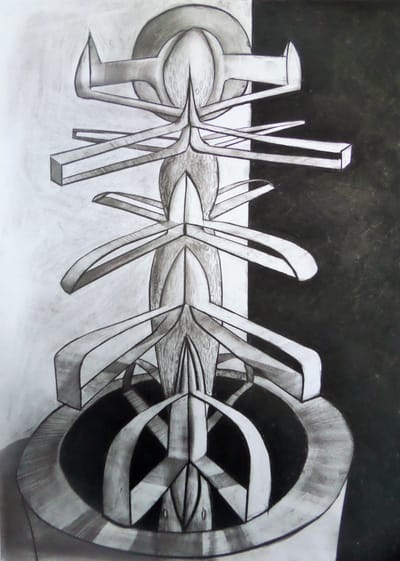About

When it comes to my artwork, I enjoy the directness and simplicity of monochromatic ‘drawing’, whichever the medium, whereby ideas are resolved more quickly. I like the strength and quality of lines that result from drawing and the speed and fluidity of using pastels and pencils so that a visually ‘more powerful’ image results. To allow my energy to flow into the drawings, the drawing activity must be intense, and this should not compromise the quality of the result.
In my paintings, I attempt to maintain the same strength of line by ‘drawing’ with the paint. Working with colour, even a limited palette, forces me to slow down the image-making process. This works well for some ideas. At other times, I consciously work more rapidly on several paintings at a time to keep the works ‘alive’ while avoiding overthinking the emerging images.
I have always been fascinated with the illusion of depth on a flat surface, spatial ambiguity, and ensuing confusion, which, to me, personifies the human condition. My works can often be interpreted in different ways, and many of my paintings can hang any way around. After all, ' Which way is up?’
Techniques:
Painting: My choice of medium is acrylic paints. I usually begin painting by sketching roughly with the paint, making lines and blocking in areas to vaguely indicate the content I have in mind. A composition emerges very quickly, and then I work back into it, looking at the whole and ignoring detail. Once a basic painted sketchy composition emerges, I decide whether to continue or abandon the work. I continue by blocking in areas with solid colour and adding tone and hue to objects. The sharpening up and focusing of edges happen simultaneously as I work around the painting, sharpening edges and creating corners. I scumble between washes to unify the composition and begin to create depth, shadow, and form where required. Finally, I ‘tighten up’ any areas that need attention, then resolve the whole image with final washes and scumbling.
Drawings: My work tools are conte crayons for dry drawing due to their ease at creating tone without reflecting light, which usually happens when a pencil is used to make darker tones. When using conte crayons, a line drawing needs to be fairly accurate right from the outset due to the medium’s habit of getting ‘into’ the paper, where it's impossible to erase a mark once it’s put down. That said, details are still possible by working into the drawing using an eraser, carefully refining lines and adjusting tones/textures/shadows…The eraser is an equally important tool in my drawings.


